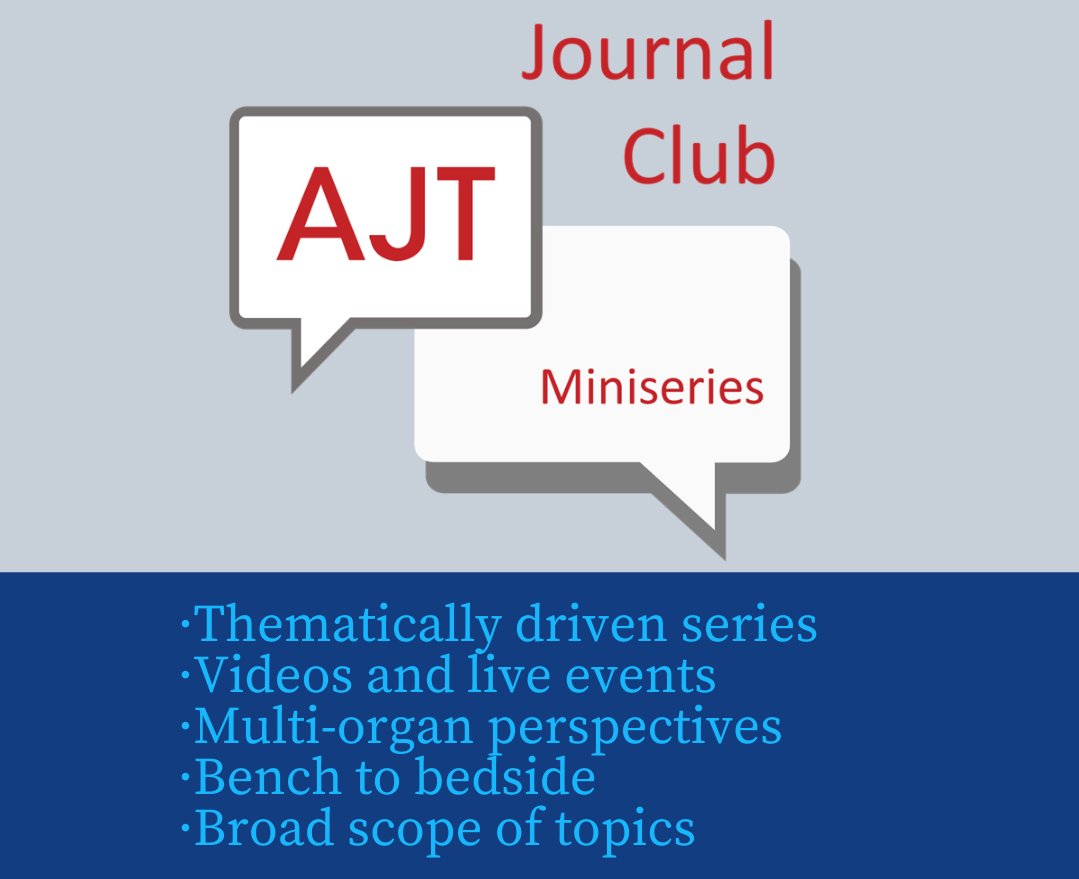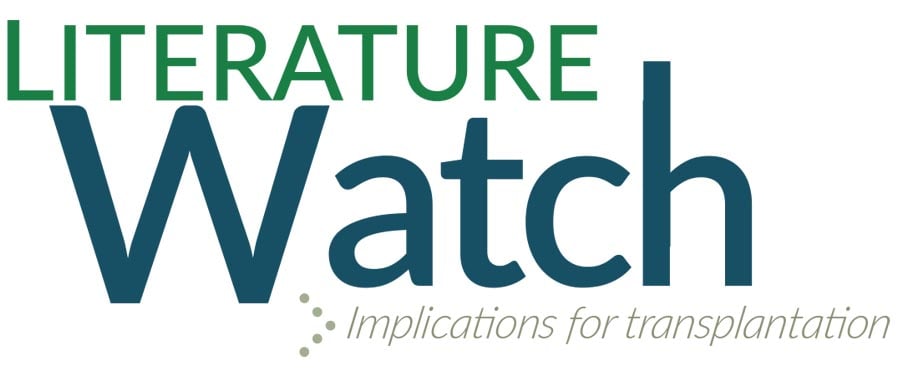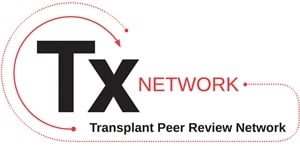Journal list menu
Export Citations
Download PDFs
The AJT Report
The AJT Report: News and issues that affect organ and tissue transplantation
- Pages: 1953-1954
- First Published: 27 August 2010
The FDA proposes granting vascularized composite allografts the definition of “organs,” giving them regulation under the Final Rule. This month, “The AJT Report” explores the implications of this potential change, takes a look at a way to track transplant program profitability, and highlights some hot topics from the American Transplant Congress.
Editorials
Cold Machine Perfusion or Static Cold Storage of Kidneys: Why the Debate Continues
- Pages: 1955-1956
- First Published: 27 August 2010
The debate regarding the efficacy of cold machine perfusion versus static cold storage for prevention of delayed graft function in organs from deceased donors continues, despite the results of two well-designed clinical trials.See article by Watson et al on page 1991.
The Molecular Phenotype of Heart Transplant Biopsies
- Pages: 1957-1958
- First Published: 27 August 2010
Molecular phenotyping of heart transplant biopsies could provide a better understanding of biopsy histology and cardiac dysfunction in allograft rejection.See article by Mengel et al on page 2105.
The ‘Two, One, Zero’ Decision: What to Do with Suboptimal Deceased Donor Kidneys
- Pages: 1959-1960
- First Published: 27 August 2010
While it is feasible to transplant two ECD kidneys into a single recipient, we need better data to help us decide with confidence whether a given set of kidneys should be transplanted into two patients, one patient, or not at all.See article by Esker et al on page 2000.
Original Articles
Laboratory Science
Beneficial Effects of Desferrioxamine on Encapsulated Human Islets—In Vitro and In Vivo Study
- Pages: 1961-1969
- First Published: 27 August 2010
Desferrioxamine treatment enhanced hypoxia inducible factor-1α and vascular endothelial growth factor expression in encapsulated human islets and improved their ability to function when transplanted into diabetic recipients.
B Cells Help Alloreactive T Cells Differentiate Into Memory T Cells
- Pages: 1970-1980
- First Published: 27 August 2010
B cell help for alloreactive T cells promotes their proliferation and survival to generate optimal numbers of functional memory T cells.
Rapamycin and MPA, But Not CsA, Impair Human NK Cell Cytotoxicity Due to Differential Effects on NK Cell Phenotype
- Pages: 1981-1990
- First Published: 27 August 2010
CsA, MPA and Rapa each have distinct effects on NK-cell phenotype and function in vitro, which may have important implications for NK-cell function in vivo after transplantation and for their use in GVHD prophylaxis.
Clinical Science
Cold Machine Perfusion Versus Static Cold Storage of Kidneys Donated After Cardiac Death: A UK Multicenter Randomized Controlled Trial
- Pages: 1991-1999
- First Published: 27 August 2010
Machine perfusion and simple cold storage of DCD kidneys produce equivalent transplant outcome in a UK multicentre randomised controlled trial.See editorial by Irish & Katz on page 1955.
Technical Aspects of Unilateral Dual Kidney Transplantation from Expanded Criteria Donors: Experience of 100 Patients
- Pages: 2000-2007
- First Published: 27 August 2010
This report presents the results of a large series of dual kidney transplantation from ECD, with a detailed description of an advantageous surgical technique of unilateral placement.See editorial by Shapiro et al on page 1959.
Marked Variation of the Association of ESRD Duration Before and After Wait Listing on Kidney Transplant Outcomes
- Pages: 2008-2016
- First Published: 27 August 2010
The previously documented association between waiting time on dialysis and reduced kidney transplant outcomes is predominantly explained by time to placement on the waiting list.
Biopsy-Diagnosed Renal Disease in Patients After Transplantation of Other Organs and Tissues
- Pages: 2017-2025
- First Published: 27 August 2010
This study of 105 renal biopsies after liver, lung, heart and bone marrow transplantation addresses whether or not calcineurin-inhibitor toxicity is the only cause of renal insufficiency after non-renal transplantation.
Primary CMV Infections Are Common in Kidney Transplant Recipients After 6 Months Valganciclovir Prophylaxis
- Pages: 2026-2032
- First Published: 27 August 2010
In a retrospective analysis of 127 Finnish CMV D+/R− kidney transplant recipients who received 6 months valganciclovir prophylaxis, 37% developed late-onset CMV infection after the end of prophylaxis and 43/47 of these infections were symptomatic.
Peritransplant Immunoadsorption for Positive Crossmatch Deceased Donor Kidney Transplantation
- Pages: 2033-2042
- First Published: 27 August 2010
This study demonstrates successful transplantation of crossmatch-positive deceased donor kidney allograft recipients using a protocol of peri-transplant immunoadsorption for rapid alloantibody depletion immediately before transplant surgery.
Increased Incidence of Colorectal Malignancies in Renal Transplant Recipients: A Case Control Study
- Pages: 2043-2050
- First Published: 27 August 2010
Comparing the frequency of colorectal neoplasia among renal transplant with that of the healthy subjects, this work could found that the renal transplant cohort had an apparent increase in their risk of advanced colorectal neoplasia.
Severe Vascular Lesions and Poor Functional Outcome in Kidney Transplant Recipients with Lupus Anticoagulant Antibodies
- Pages: 2051-2060
- First Published: 27 August 2010
In a retrospective study, the presence of lupus anticoagulant at the time of transplantation was associated with a high rate of thrombosis, the hallmark lesions of antiphospholipid syndrome associated nephropathy, an increase in chronic vascular scores and a faster decline in mGFR.
Allotransplantation of Cryopreserved Parathyroid Tissue for Severe Hypocalcemia in a Renal Transplant Recipient
- Pages: 2061-2065
- First Published: 25 August 2010
A renal transplant recipient with life threatening post parathyroidectomy hypocalcemia was successfully treated with an allotransplant using cryopreserved parathyroid tissue from a third party.
Inflammation in Areas of Tubular Atrophy in Kidney Allograft Biopsies: A Potent Predictor of Allograft Failure
- Pages: 2066-2073
- First Published: 27 August 2010
A more global assessment of inflammation in kidney allograft biopsies to include inflammation in atrophic areas may provide critical insight into the prognosis of late graft injury.
Influence of Recipient Race on the Outcome of Simultaneous Pancreas and Kidney Transplantation
- Pages: 2074-2081
- First Published: 27 August 2010
Inferior pancreas and kidney graft survival in African American SPK patients
Experience with a Novel Efalizumab-Based Immunosuppressive Regimen to Facilitate Single Donor Islet Cell Transplantation
- Pages: 2082-2091
- First Published: 25 August 2010
Carefully selected patients with T1DM can be rendered insulin independent after a single islet infusion with a novel efalizumab-based immunosuppressive regimen.
An Early Regional Experience with Expansion of Milan Criteria for Liver Transplant Recipients
- Pages: 2092-2098
- First Published: 27 August 2010
This multicenter, prospective study showed benefit of orthotopic liver transplantation in patients exceeding Milan Criteria based on preoperative imaging.
Anonymous Living Liver Donation: Donor Profiles and Outcomes
- Pages: 2099-2104
- First Published: 27 August 2010
In a center experienced in live liver donation, anonymous donors are altruistic individuals who can successfully enhance the donor pool with acceptable morbidity similar to that of living-related liver donors.
The Molecular Phenotype of Heart Transplant Biopsies: Relationship to Histopathological and Clinical Variables
- Pages: 2105-2115
- First Published: 27 August 2010
Assessing 105 endomyocardial allograft biopsies by Affymetrix microarrays revealed that the current ISHLT system for diagnosing rejection does not reflect the molecular phenotype and lacks clinical relevance; and that the interpretation of Quilty lesions are more strongly associated with the molecular phenotype than current ISHLT rejection grades.See editorial by Marboe on page 1957.
Association of Race and Socioeconomic Position with Outcomes in Pediatric Heart Transplant Recipients
- Pages: 2116-2123
- First Published: 27 August 2010
This multi-center study of pediatric heart transplant recipients suggests a complex relationship between recipient socioeconomic position and graft loss
Solid Organ Transplantation in AL Amyloidosis
- Pages: 2124-2131
- First Published: 27 August 2010
Solid organ transplantation has historically been contentious in systemic AL amyloidosis because of the multisystem nature of the condition as well as the theoretical risk of graft amyloid recurrence, but this series highlights the outcomes and feasibility of transplantation in selected individuals.
Immune Reconstitution Following Rabbit Antithymocyte Globulin
- Pages: 2132-2141
- First Published: 27 August 2010
This prospective study examines the contribution of thymopoiesis versus homeostatic proliferation to immune reconstitution following rATG and the influence of rATG on the emergence of Treg in renal transplant recipients.
Brief Communications
Successful Isolated Liver Transplantation in a Child with Atypical Hemolytic Uremic Syndrome and a Mutation in Complement Factor H
- Pages: 2142-2147
- First Published: 25 August 2010
Pre-emptive liver transplantation prior to the development of endstage renal disease is a valuable option in the management of atypical haemolytic uraemic syndrome associated with complement factor H mutations.
No-Touch Hepatic Hilum Technique to Treat Early Portal Vein Thrombosis After Pediatric Liver Transplantation
- Pages: 2148-2153
- First Published: 27 August 2010
The authors describe an effective novel technique for treating early portal vein complications post-liver transplantation in five infants, with a combination of minimal surgery without liver hilum manipulation and endovascular treatment.
Case Reports
Eculizumab, Bortezomib and Kidney Paired Donation Facilitate Transplantation of a Highly Sensitized Patient Without Vascular Access
- Pages: 2154-2160
- First Published: 27 August 2010
For a young patient with 100% PRA and loss of vascular access, several non-traditional therapies (bortezomib, domino paired kidney donation, splanchnic venous drainage of the graft, and eculizumab) were combined to achieve successful renal transplantation.
Fatal Apophysomyces elegans Infection Transmitted by Deceased Donor Renal Allografts
- Pages: 2161-2167
- First Published: 25 August 2010
This study examines the source of renal mucormycosis transmitted to two recipients by donated organs recovered from a near-drowning victim.
Combined Pancreas and En Bloc Kidney Transplantation Using a Bladder Patch Technique From Very Small Pediatric Donors
- Pages: 2168-2172
- First Published: 27 August 2010
Pancreas, kidney, and bladder patch grafts from two donors younger than two years old were successfully transplanted into adult recipients.
Extracorporeal Membrane Oxygenation in Nonintubated Patients as Bridge to Lung Transplantation
- Pages: 2173-2178
- First Published: 27 August 2010
The use of ECMO in fully awake patients is a promising bridging strategy for patients with terminal cardiopulmonary failure.
Letters to the Editor
Single Kidney Transplantation from Young Pediatric Donors in the United States
- Page: 2179
- First Published: 27 August 2010
Single Kidney Transplantation from Young Pediatric Donors in the United States
- Page: 2180
- First Published: 27 August 2010
Intraoperative No Go Donor Hepatectomy in Living Donor Liver Transplantation
- Pages: 2181-2182
- First Published: 27 August 2010
Preventing CMV Viremia and Disease 3–6 Months After Renal Transplantation
- Page: 2184
- First Published: 27 August 2010
Preventing CMV Viremia and Disease 3–6 Months After Renal Transplantation
- Page: 2185
- First Published: 27 August 2010










.jpg)
